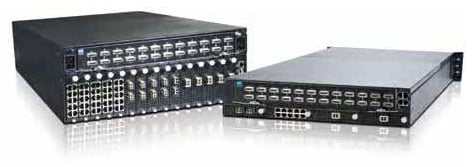This article is more than 1 year old
Xsigo scales down server I/O virtualizer
Attack of the pod people
The rack is becoming the new chassis for IT infrastructure, despite the best efforts of the major blade server providers to have their own blade enclosures (incompatible with others' tools and form factors) become the unit of control for a bunch of servers and their switches. Which is why upstart server I/O virtualizer Xsigo Systems is cutting back its I/O Director to deliver an entry box that is suitable for a single rack.
By thinking at the rack level, rather than across racks or within individual rack servers or blade enclosures, companies can deploy pre-integrated IT stacks of servers, storage and switches for linking them all together in what is commonly called a pod.
The VP780 I/O Director, launched in the fall of 2007, uses InfiniBand switching as a backbone for converged server and storage interconnections. It is akin to the converged 10 Gigabit Ethernet fabric espoused by Cisco Systems in its "California" Unified Computing System, only the Xsigo approach uses an InfiniBand switch and InfiniBand cabling to link devices together. A single host channel adapter goes into each server, linking back to the VP780 Director, and that HCA can support up to 64 virtual connections for server or storage linkage within each server.
The VP780 I/O Director has 24 non-blocking ports out to the servers and can scale to as much as 400 servers using expansion switches that daisy chain onto this director switch. The VP780 may use InfiniBand itself, but it has I/O modules that allow for linking out to Gigabit Ethernet, 10 Gigabit Ethernet, or 4 Gb/sec Fibre Channel networks. The VP780 unit comes in a 4U chassis and has 15 I/O slots with 20 Gb/sec full duplex bandwidth per slot.
The new VP560 I/O Director announced today is based on the same technology, but is a cut-down version of the box that has a lower price and is designed to scale to the 30 to 40 servers that customers typically plunk into a standard 42U server rack.

The Xsigo Systems VP780 (left) and VP560 (right) I/O Directors
As you can see from the picture above, the VP560 I/O Director has the same 24 non-blocking ports out to the servers, but its 2U chassis only has room for four I/O modules. Those I/O modules can be Gigabit, 10 GE, or 4 Gb/sec FC modules, as with the VP780 director switch.
The VP560 supports the same 64 virtual NICs and HBAs per server with just one physical cable and one Xsigo HCA that the VP780 does. That high NIC and HBA count is necessary to support the increasingly virtual server environments in the data center, so you can put one virtual NIC and HBA per virtual machine.
According to Jon Toor, vice president of marketing at Xsigo, the VP560 I/O Director is not limited to one rack if customers want to expand beyond three dozen servers or so. The 2U chassis can be extended with three expansion switches, which raises the port count to 72 but a dozen of them are eaten up for cross-linking the switches, so you are left with 60 ports out to the servers.
Such daisy chaining defeats the purpose of the pod approach. Toor says that in many cases, customers were not using the additional scale in the VP780 and were building at the rack level, and the new VP560 product offers the right scale for the right price for those building rack-level pods.
The VP560 I/O Director may be half the size of the VP780, but its price is not. The base P780 costs $30,000, but the entry VP560 will run you $20,000. That's because the switch has the same 1.5 Tb/sec fabric and the same 24 system control modules, which is a floor for how low Xsigo can drop the price.
Interestingly, Toor says that a lot of customers are installing two VP780 I/O Directors to have fully redundant linkage between systems and storage. So customers doubling up directors are going to see a significant savings - enough to cover the costs of buying quite a few servers.
No word on when Xsigo will move to a 40 Gb/sec InfiniBand backbone for its directors or when it will support 8 Gb/sec Fibre Channel modules, but clearly these must be in the works.
Dell and Hitachi are peddling the old and new Xsigo boxes, and the machines have been certified to work with servers from Hewlett-Packard, IBM, Oracle and Super Micro.
The VP780 and VP560 I/O Directors support Microsoft Windows Server, Red Hat Enterprise Linux, and Oracle Solaris for operating systems and support VMware ESX Server, Citrix Systems XenServer, Microsoft Hyper-V, and Oracle VM for server virtualization hypervisors. Storage arrays based on Fibre Channel, iSCSI, and NAS protocols from Dell, 3Par, Compellent, EMC, Hitachi, HP, IBM (DS and XIV), NetApp, and Pillar Data have been certified to work with the director switches. ®
